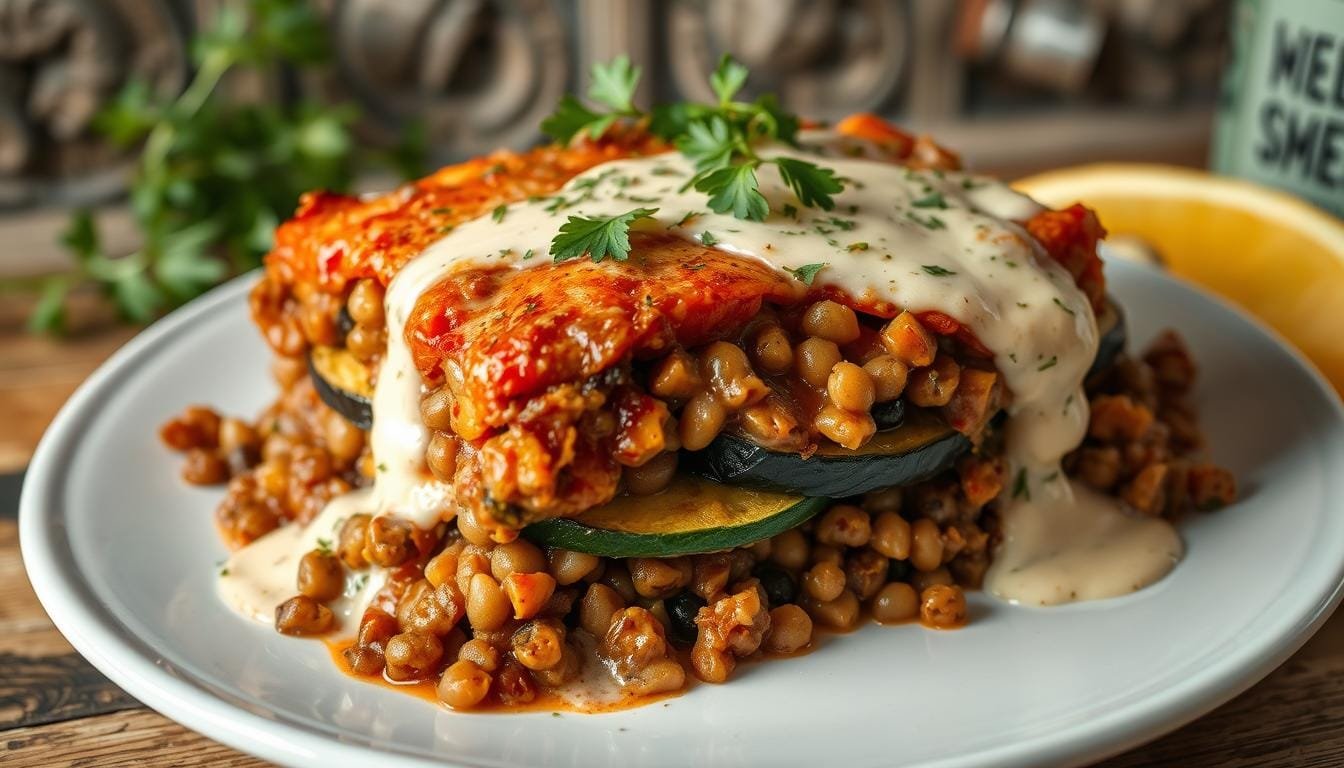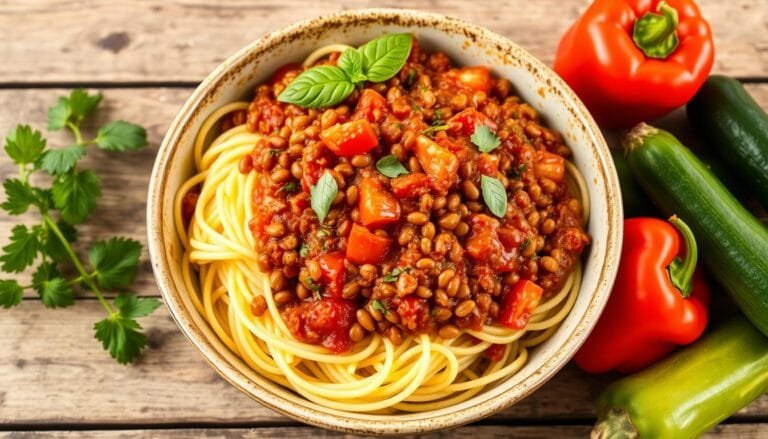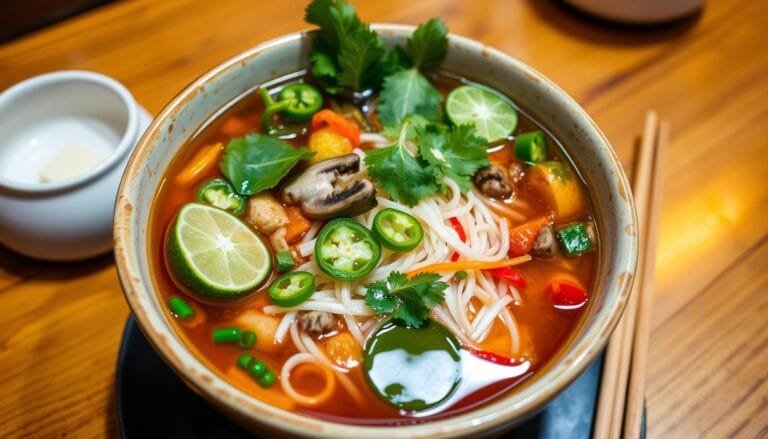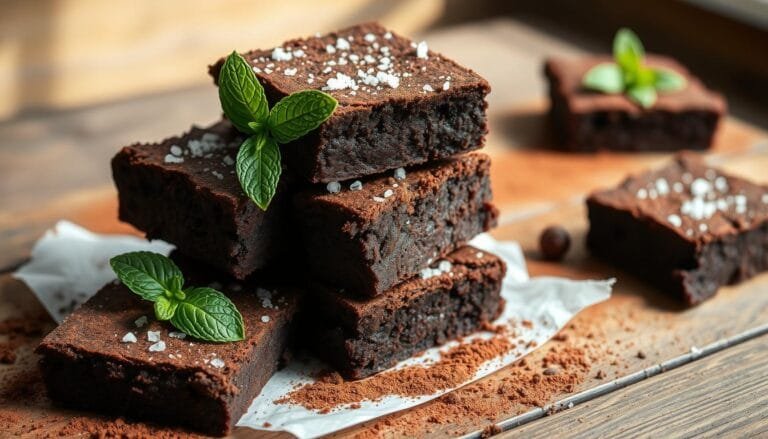I love cooking at home and exploring Mediterranean cuisine. Moussaka, with its rich flavors and comforting texture, has always been a favorite. But, as I started eating more plant-based, I wanted a vegan version that was just as good.
That’s when I found vegan moussaka. It’s a meatless, dairy-free dish that keeps the classic Mediterranean taste. Plus, it’s healthy and good for the planet.
In this article, I’ll show you how to make a fantastic vegan moussaka. It’s packed with layers of roasted veggies, a lentil-mushroom filling, and a creamy cashew béchamel sauce. This recipe is a true plant-based masterpiece.
This vegan moussaka is amazing because it stays true to the original while being plant-based. The lentils and walnuts in the “meat” layer give it a meaty feel. The eggplant and potatoes add creaminess and heartiness.
The cashew-based béchamel sauce is the perfect topping. It’s rich and creamy, just like the real thing.
History and Origins of Mediterranean Moussaka
The story of moussaka, a favorite Greek dish, starts in the Levant region. Over time, it became popular across the Mediterranean, with each culture adding its own twist. The Greek version, with eggplant, meat, and béchamel sauce, is now famous worldwide.
Traditional Greek Influence
In Greece, moussaka is seen as a national dish. But its history goes back to the Ottoman era, influenced by Turkish and Arabic cooking. The Greek version we know today was created in the 1920s by Nikolaos Tselementes, a famous chef.
Evolution to Plant-Based Version
With more people wanting plant-based foods, moussaka has changed. Now, there are vegan and vegetarian versions that keep the dish’s rich taste and texture. These use ingredients like lentils, mushrooms, or vegetables, making it a satisfying choice for those who don’t eat meat.
Cultural Significance
Moussaka is a beloved part of Greek culture, enjoyed at home more than in restaurants. Its many variations show the diversity of Greek cuisine. From eggplant in mainland Greece to potatoes in the Balkans, moussaka’s history and plant-based versions highlight its creativity and adaptability.
Essential Ingredients for Plant-Based Moussaka
Making a tasty vegan moussaka begins with picking the right ingredients. This plant-based version of the Greek dish needs substitutes that taste like the real thing but are healthier.
The core of this recipe includes the vegan moussaka ingredients. These are:
- Eggplant (aubergine): A key part that gives the dish its texture and heartiness.
- Potatoes: Layered with eggplant to make a great vegetable base.
- Lentils or mushrooms: These plant-based substitutes act as the protein-rich “meat” filling.
- Tomatoes: Canned or fresh, adding a nice acidity and sweetness.
- Onions and garlic: For a rich, aromatic flavor.
- Herbs like oregano and dill: Bringing the authentic Mediterranean taste.
The creamy vegan béchamel sauce needs plant-based milk, flour, and a special ingredient – nutritional yeast. It gives a cheesy taste. Spices like cinnamon, nutmeg, and smoked paprika add to the flavor.
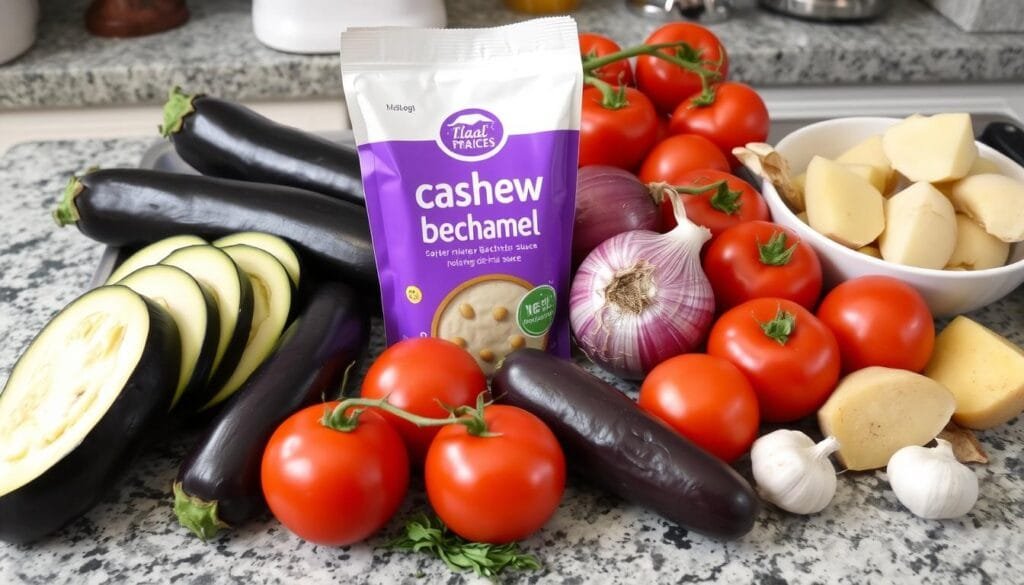
With these vegan moussaka ingredients and plant-based substitutes, you’re ready to make a delicious, guilt-free version of this classic dish.
The Perfect Vegetable Layers: Eggplant and Potatoes
Plant-based moussaka starts with the right vegetables. Eggplant and potatoes are key, needing careful prep for the best taste and texture.
Proper Slicing Techniques
Slice the eggplant and potatoes thinly, about 1/4 inch. This ensures even cooking and a nice look. Slice them lengthwise for a uniform dish.
Pre-Roasting Tips
Pre-roasting is a must before making the moussaka. Heat your oven to 500°F. Brush the slices with olive oil and season with salt and pepper.
Roast the eggplant for 10-15 minutes and the potatoes for 15-20 minutes. They should be tender and golden. This step boosts flavor and texture.
Seasoning Secrets
Seasoning is key for the Mediterranean taste of plant-based moussaka. Use plenty of salt and pepper on the vegetables. It brings out their sweetness and balances flavors.
With the right slicing, pre-roasting, and seasoning, you’ll make a delicious plant-based moussaka. It will impress your taste buds and senses.
Creating the Hearty Lentil-Mushroom Filling
The lentil-mushroom filling is the heart of our plant-based moussaka. It combines cooked lentils, sautéed mushrooms, onions, and garlic. This mix mimics the traditional meat-based sauce in both texture and flavor.
Diced tomatoes, fragrant herbs like oregano and dill, and warm spices like cinnamon and smoked paprika add depth. A touch of cayenne pepper gives it a kick.
The secret to a perfect vegan moussaka filling is cooking it until it’s thick and flavorful. This filling offers a satisfying, meaty texture. It also has a rich, savory taste that goes well with the layers of roasted eggplant and potatoes.
- Start by sautéing diced onions and minced garlic in a large skillet until fragrant and translucent.
- Add sliced mushrooms and continue cooking until the mushrooms have released their moisture and developed a deep, caramelized flavor.
- Stir in cooked lentils, either canned or freshly prepared, and let the mixture simmer, allowing the flavors to meld.
- Incorporate diced tomatoes, along with a generous amount of dried oregano, fresh dill, cinnamon, smoked paprika, and a pinch of cayenne pepper.
- Season with salt and pepper to taste, and continue cooking until the lentil mushroom recipe has thickened to your desired consistency.
With this flavorful and hearty vegan moussaka filling as the foundation, you’re well on your way to creating a plant-based moussaka that will satisfy even the most discerning palates.
Mastering the Vegan Béchamel Sauce
Making the perfect vegan béchamel sauce is key to a great plant-based vegan béchamel moussaka. This creamy topping makes the dish stand out. We’ll look at two cashew-based options for that smooth, rich texture and taste.
Cashew-Based Alternatives
For a creamy, dairy-free béchamel, blend soaked cashews with unsweetened cashew cream sauce, nutritional yeast, and spices. The cashews make it creamy, and the nutritional yeast adds a cheesy flavor.
Achieving the Perfect Consistency
You can also make a roux-based vegan béchamel. Start by melting vegan butter in a pan. Then, whisk in flour to make a paste. Slowly add plant-based milk, whisking all the time, until it thickens. Add nutmeg, garlic powder, and salt for extra flavor.
Flavor Enhancement Tips
- Adding a tablespoon or two of nutritional yeast boosts the umami flavor.
- A pinch of ground nutmeg adds a warm, comforting taste.
- Garlic powder or a minced garlic clove can make the béchamel more savory.
Whichever method you pick, whisking constantly is key to a smooth sauce. With practice, you’ll get the hang of making the perfect vegan béchamel for your moussaka.
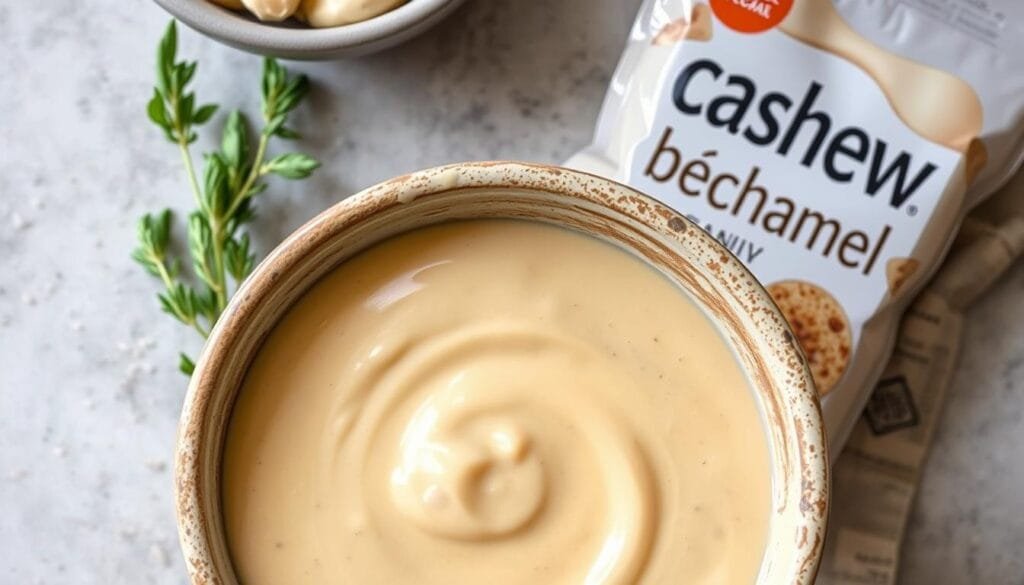
Plant-Based Moussaka: Step-by-Step Assembly
Making the perfect plant-based moussaka is a fun journey. Let’s go through the steps to put together this hearty dish:
- Begin with a layer of roasted potatoes at the bottom of your baking dish. Cut the potatoes into 1/4-inch slices. Roast them at 350°F until they’re tender, about 25 minutes.
- Then, spread half of the lentil-mushroom filling over the potatoes. This filling, made with lentils and plant-based meat, adds a savory taste.
- Place the roasted eggplant slices on top of the filling. Pre-roast the eggplant at 425°F for 30 minutes to remove excess moisture.
- Put the remaining lentil-mushroom filling on top of the eggplant.
- Add another layer of roasted eggplant slices.
- Pour the creamy vegan béchamel sauce over the top, covering the whole surface.
- For a golden, crunchy topping, sprinkle 1/3 cup of panko breadcrumbs or shredded vegan cheese over the sauce.
Your layering moussaka and vegan moussaka assembly are now complete. Now, bake it until it’s bubbly and golden brown. Your kitchen will fill with the amazing smell of Mediterranean flavors.
Baking Techniques and Timing
To make a perfect plant-based moussaka, follow key baking techniques and timing. Preheat your oven to 375°F (190°C) before you start. Then, layer your moussaka and let the oven work its magic.
Temperature Guidelines
Bake the moussaka for 35 to 40 minutes. It should be golden brown and bubbly. For a caramelized crust, broil it for 1 to 2 minutes more.
Visual Cues for Doneness
- The top should be golden, with bubbly béchamel sauce.
- Check if the eggplant and potatoes are tender with a toothpick or fork.
- Look for crisp, brown edges to know it’s done.
After baking, wait 30 minutes to 2 hours before serving. This lets the flavors mix and the layers set. It makes for a better taste and texture.
| Metric | Value |
|---|---|
| Prep Time | 40 minutes |
| Cook Time | 45 minutes |
| Total Time | 1 hour 25 minutes |
| Calories per serving | 313 kcal |
| Servings | 8 people |
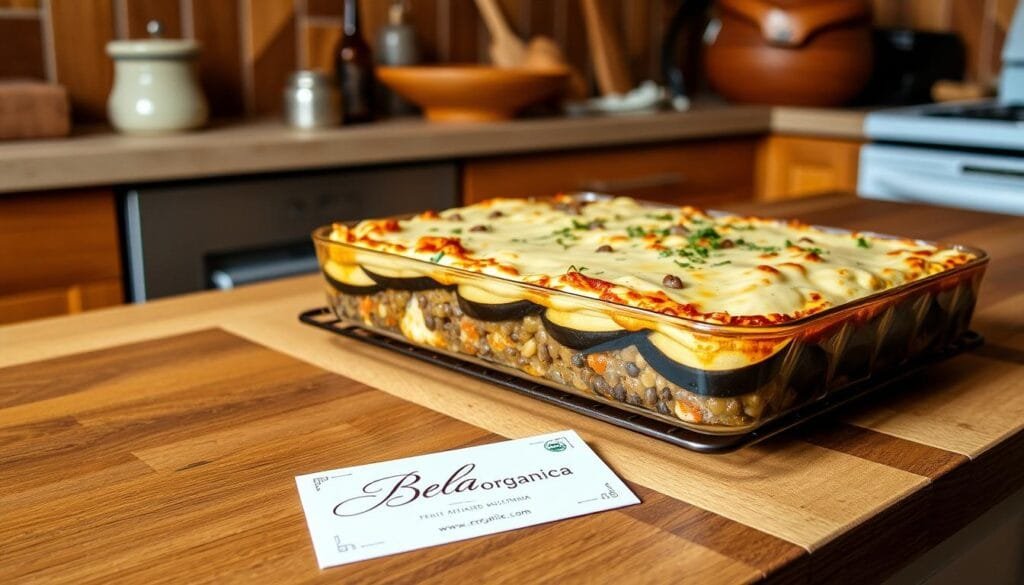
By using these baking tips, you’ll make a stunning plant-based moussaka. It will be full of flavor. Share this delicious Mediterranean dish with your family and friends!
Make-Ahead and Storage Solutions
Preparing a plant-based moussaka is a labor of love. The good news is you can make it ahead of time. It can be assembled up to 2 days in advance and refrigerated before baking.
For meal prep moussaka, layer roasted eggplant, lentil-mushroom filling, and vegan béchamel sauce in a casserole. Cover and refrigerate until baking time. This lets the flavors and textures meld, making it even more delicious.
If you have storing vegan moussaka leftovers, don’t worry. It can be stored in the fridge for up to 4 days. For longer storage, freeze individual portions for up to 3 months. Reheat in a 350°F oven for 20-30 minutes until warm.
| Storage Option | Shelf Life | Reheating Instructions |
|---|---|---|
| Assembled, unbaked moussaka | Up to 2 days in the refrigerator | Bake at 375°F for 45-60 minutes |
| Baked moussaka leftovers | Up to 4 days in the refrigerator | Reheat in a 350°F oven for 20-30 minutes |
| Frozen, individual portions | Up to 3 months in the freezer | Thaw in the refrigerator, then reheat in a 350°F oven for 20-30 minutes |
Use these make-ahead and storage tips to enjoy plant-based moussaka all week. It’s perfect for busy weeknights. Enjoy the Mediterranean flavors whenever you want.

Serving Suggestions and Mediterranean Pairings
There are many ways to serve this tasty plant-based moussaka. I enjoy it with a Greek salad. The salad has fresh tomatoes, cucumbers, and a zesty lemon-herb dressing. It’s a perfect match for the moussaka’s rich taste.
For a bigger meal, try it with garlic-infused toasted bread. The garlic adds a nice Mediterranean touch. Roasted veggies like zucchini, bell peppers, and onions also pair well. They add color and texture.
To make it a full Mediterranean meal, add creamy hummus, fragrant tabbouleh, or lemon-infused rice. These dishes bring the region’s vibrant flavors to your plate. Top it off with fresh herbs like parsley or basil. For a drink, a vegan-friendly red wine like Merlot or Pinot Noir is great.
